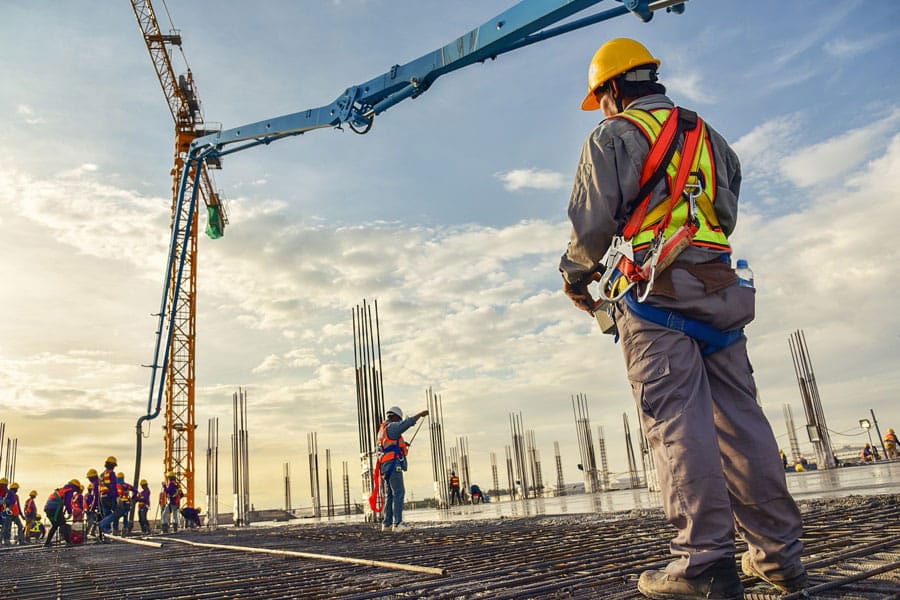When construction technology entrepreneurs Roy Danon, Aviv Leibovici and Yakir Sudry first met as members of the Israeli Defense Forces, they knew nothing about the industry and its potential as a springboard for innovation.
What they did know: none of the three were particularly good foot soldiers, so the trio went on to graduate from the IDF’s elite Talpiot program for budding scientists and technology leaders.
After completing their service, the three knew they wanted to put their skills to work by launching a company that would use some of the technologies they learned in the military to boost the efficiency of a particular industry.
The problem: they didn’t know what industry that would be.
After surveying the business landscape, the three quickly zeroed in on the role of artificial intelligence (AI) in construction, taking an immediate liking to the field. They now run Buildots, an AI firm focused on helping the construction industry maximize its use of nascent technology.
“We fell in love with construction in the process of exploring what we were going to do,” said Danon, the company’s CEO. “It is a process-oriented industry with very process-oriented people.”
But the trio also spotted an opportunity, with an industry that should be using AI productivity tools to boost its efficiency but instead found itself struggling to keep up with the pace of innovation.

The three spent the next several months visiting construction jobsites, interviewing executives and engineers and asking them what sort of things “kept them up at night,” Danon recalled in an interview with Built.
From these discussions, Danon and his fellow entrepreneurs said they realized construction project managers and executives need a more in-depth understanding of what is happening on the jobsites they oversee and where things stand in meeting various project milestones, creating a perfect opportunity to apply AI in construction project management.
Enter Buildots, which the three launched in 2018; by early 2020, the company had landed $16 million in venture capital funding for its project progress tracking platform, which boosts construction efficiency by keeping tabs on everything happening on a jobsite, from the installation of electrical sockets to hanging drywall.
Buildots declined to name specific customers, but the company says its roster includes two of the 10 largest construction firms in Europe and the largest Israeli construction firm. The startup has also begun working with potential clients on the West Coast of the United States.
“What is happening on the construction site is not where it should be,” Danon said. “The industry is investing so much in building good plans, but you are still using Excel spreadsheets to manage scheduling. This is where we thought we could make a difference, in closing the gap.”
How it works
A key part of Buildots’ construction tracking platform involves rigging the hardhat of a site supervisor with cameras and then capturing 360-degree footage of the building process as they walk the jobsite.
The data captured by the hardhat cameras is then fed into the Buildots platform, where it is compared to the project designs and schedule to measure progress.
Danon said this is a far more cost-effective and practical solution than installing semi-permanent cameras and sensors across the construction site, which he said would be too costly.
While sensors and cameras are used in factories, they are installed for long-term use, with the cost of the investment spread out over time. Construction sites are temporary and often quite large.
“You can’t really invest in sensors as you would in a manufacturing site—the cost of putting sensors all over the place is cost prohibitive,” Danon said.
Instead, Buildots relies on less expensive, off-the-shelf cameras.
“The capturing process is usually done by the supervisor turning the camera,” Danon said. “It’s so passive they can do that during their existing walk [around the constructions site]. “They don’t have to do anything but turn the camera on. While they walk, the data is being captured.”
The Buildots platform comes with a mini control center in the form of a dashboard system that appears atop the computer screen. This dashboard alerts project managers with monthly updates and notifications when it detects signs that work being done clashes with the 3D model, among other things.
Some clients, however, have chosen to create actual control rooms, with the Buildots platform displayed on large-screen TVs.
“It’s a reminder to everyone who enters the site office what is going on,” Danon said.
Faster and more efficient
Buildots’ platform goes well beyond just taking pictures, which is just the first step of the process.
Rather, Buildots’ software uses algorithms and deep learning to both track key tasks and generate data that can be analyzed by project managers.
The system eliminates the far more time-consuming way progress is traditionally tracked on a jobsite, which often requires getting out the measuring tape and opening various paper-based files.
By tracking progress on multiple facets of a project, supervisors can compare how the plumbers, carpenters or ironworkers, for instance, are doing in meeting various milestones and goals, while raising the alert if a particular subcontractor appears to be behind schedule.
MORE ON TECH ADOPTION:
Other members of the project team can also use the data generated by the Buildots platform, including architects and finance staff looking to send out invoices based on construction having hit certain milestones.
Buildots’ sweet spot right now is in residential, hotel and office construction, where building tasks are often repetitive given the nature of those structures, Danon said.
The company’s software platform is designed to track progress on those repetitive tasks, whether it’s the installation of electrical sockets and windows to progress on walls and framing.
“Capturing an enormous amount of visual data is great, but analyzing what is happening and connecting the dots really drives the process forward and makes it efficient,” Danon said.
Part of a fast-growing sector
As of this writing, Buildots is testing out its technology with 10 clients, with hopes of expanding that number soon to 15.
The company has 60 employees split between a 25-member software engineering team in Israel and sales and marketing staff in the U.K.
Buildots is one of a growing number of technology and AI firms looking to change the ways things are done in construction—and investors are opening up their checkbooks.
Launched in 2017, OpenSpace recently raised $55 million in venture capital and has developed a platform similar to what Buildots offers, using cameras strapped to a site manager’s hardhat to collect images that can be analyzed to track a project’s progress.
Tishman Speyer, an investor in the firm, said it has used the technology on San Francisco’s MIRA building and the 65-story Spiral tower in New York, according to Venture Beat.
Other AI startups are exploring additional potential niches in the construction sector. One is Alice, which has raised $8 million and which tracks labor and equipment; another is Avvir, which sells a platform that deploys mobile lasers around the construction site to catch mistakes. Investors recently pumped $10 million into the company.
Meanwhile, leaders in construction, design, engineering and venture capital recently teamed up with the University of Illinois and Carnegie Mellon University to start hammering out plans for a National Institute for Artificial Intelligence in Construction, according to Construction Dive.
Technology still in its “infancy”
While there is a lot of potential when it comes to using AI in the construction industry, it is still largely in its infancy, according to Amir Behzadan, an associate professor at Texas A&M University.
The big challenge is “how you analyze the data … and figure out the algorithms they need,” Behzadan said.
Training the AI system and the computer to recognize the images are the far more challenging part. It can also be a painstaking process.
“The majority [of companies] are still at the very initial stages of data collection,” Behzadan said, adding that “data collection is just the first stage.”
The next—and more challenging—step is the difficult process of teaching the computer to recognize various images and patterns.
“The visual information is not understandable to the computer on its own,” Behzadan said. “Someone has to sit down and analyze these images … and do data annotation.”
That said, the idea driving companies like Buildots to collect jobsite construction data and compare actual progress with project plans and timetables is “very viable,” Behzadan said.
As it stands now, “there is a tremendous amount of human resources in construction spend trying to figure out deviations from plans,” Behzadan said. “Collecting this data has been very time-consuming—someone has to manually sit down and stitch them together and compare the [data collected] to the drawings.”
Still, Behzadan said, employing cameras has “made the process of data collection much faster.”















